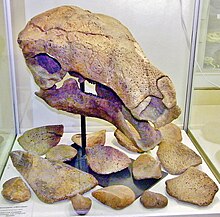Denversaurus
| Denversaurus Temporal range:Late Cretaceous,
| |
|---|---|

| |
| Skeleton cast ofDenversaurus( "Tank" ),Houston Museum of Natural Science | |
| Scientific classification | |
| Domain: | Eukaryota |
| Kingdom: | Animalia |
| Phylum: | Chordata |
| Clade: | Dinosauria |
| Clade: | †Ornithischia |
| Clade: | †Thyreophora |
| Clade: | †Ankylosauria |
| Family: | †Nodosauridae |
| Subfamily: | †Nodosaurinae |
| Clade: | †Panoplosaurini |
| Genus: | †Denversaurus Bakker, 1988 |
| Type species | |
| †Denversaurus schlessmani Bakker, 1988
| |
Denversaurus(meaning "Denver lizard" ) is a genus ofpanoplosaurinnodosauriddinosaurfrom the lateMaastrichtianofLate CretaceousWestern North America. Although at one point treated as ajunior synonymofEdmontoniaby sometaxonomists,current research indicates that it is its own distinct nodosauridgenus.
Discovery and naming[edit]

In 1922,Philip Reinheimer,a collector and technician employed by the Colorado Museum of Natural History, the predecessor of the presentDenver Museum of Nature and Science,near the Twito Ranch inCorson County, South Dakotadiscovered the fossil of an ankylosaurian in aMaastrichtianage terrestrial horizon of theLance Formation.In 1943,Barnum Brownreferred the find toEdmontonia longiceps.[1]
In 1988,Robert Thomas Bakkerdecided to split the genusEdmontonia.The speciesEdmontonia rugosidenswas made into a separate genus namedChassternbergiaand the Denver fossil was named and described as a new genus and species. Thetype speciesof this genus wasDenversaurus schlessmani.The generic name referred to the Denver Museum of Natural History atDenver, Colorado.Thespecific namehonoured Lee E. Schlessman, a major benefactor of the museum and the founder of the Schlessman Family Foundation.[2]
The fossil the species is based on, holotype specimenDMNH 468,was discovered in an aforementioned layer of the late Maastrichtian-ageLance FormationofSouth Dakota.It consists of a skull without the lower jaws and a number ofosteodermsof the body armour. It is part of the collection of the Denver Museum of Nature and Science after which the genus was named. Bakker referred a second fossil to the species, specimen AMNH 3076, a skull found by Brown andAmerican Museum of Natural HistorypaleontologistRoland T. Birdat the Tornillo Creek inBrewster County, Texas,in a layer of the poorly datedUpper CretaceousAguja Formation,possibly from the Maastrichtian too.[2]
Fossil hunters found a nodosaurid skeleton inNiobrara County, Wyoming,nicknamed "Tank", which has been identified asDenversaurus.The specimen contains the lower jaws, parts of the torso, and about a hundred osteoderms. It is part of the collection of theRocky Mountain Dinosaur Resource Centerunder inventory number BHI 127327.[3]
The validity ofDenversauruswas disputed in a 1990 paper on ankylosaurian systematics byKenneth Carpenter,who noted that Bakker's diagnosis ofDenversauruswas based primarily on Bakker's artistic restoration of the holotype in an uncrushed state. Since DMNH 468 was found crushed, Carpenter assignedDenversaurusto anEdmontoniasp., even though he noted its similarity toEdmontonia rugosidens.[4]A number of workers treatedDenversaurusas synonymous with eitherE. rugosidens[5]orE. longiceps,[6]or alternatively as a valid species ofEdmontonia:E. schlessmani.[7][8]
In an SVP 2015 abstract, Michael Burns revisited the systematics of latest Cretaceous nodosaurids from the Western Interior. According to Burns,Denversaurusis a valid taxon based on itsphylogeneticposition.[9]
Description[edit]

In 2010, AmericanpaleontologistGregory S. Paulestimated the length ofDenversaurusat 6 metres (20 ft) and its body mass at 3 tonnes (3.3 short tons).[8]
Robert T. BakkerconsideredDenversaurusdistinct fromEdmontoniaandChassternbergiain having a skull that was wide at the rear and a more rearward position of the eye sockets.[2]The holotype skull has a length of 496 millimetres and a rear width of 346 millimetres. In the referred specimenAMNH3076, these proportions are less extreme, measuring 395 millimetres long with a rear width of 220 millimetres. According to American paleontologistKenneth Carpenter,the greater width of both the holotype and the referred specimen was due to crushing.[4]
In 2015, vertebrate anatomist and paleontologist Michael Burns published an abstract concluding thatDenversauruswas different fromEdmontonia,but similar toPanoplosaurusin having inflated, convex, cranial sculpturing with visible sulci, or troughs, between individual top skull armour elements, but is distinct fromPanoplosaurusin having a relatively wider snout.[9]
Classification[edit]
In 1988, Bakker placedDenversauruswithinEdmontoniidae,the presumedsister groupofNodosauridaewithinNodosauroideathat would not have beenAnkylosauria,but the last survivingStegosauria.[2]However, these hypotheses have not been confirmed by moderncladisticanalysis. Whether it presents a separate species or is identical toE. rugosidensorE. longiceps,Denversaurusmaterial is considered nodosaurid and ankylosaurian. Paul suggested that it was the direct descendant ofE. longiceps.[8]Burns recoveredDenversaurusas thesister speciesofPanoplosaurus.[9]Denversaurusis the latest known member ofThyreophora.[2]
References[edit]
- ^B. Brown and E.M. Schlaikjer, 1943, "A study of the troödont dinosaurs with the description of a new genus and four new species",Bulletin of the American Museum of Natural History82(5): 115-150
- ^abcdeBakker, R.T. (1988). "Review of the Late Cretaceous nodosauroid Dinosauria:Denversaurus schlessmani,a new armor-plated dinosaur from the Latest Cretaceous of South Dakota, the last survivor of the nodosaurians, with comments on Stegosaur-Nodosaur relationships ".Hunteria1(3): 1-23.(1988).
- ^Carpenter K., DiCroce T., Kinneer B., Simon R., 2013, "Pelvis ofGargoyleosaurus(Dinosauria: Ankylosauria) and the Origin and Evolution of the Ankylosaur Pelvis ",PLoS ONE8(11): e79887.doi:10.1371/journal.pone.0079887
- ^abCarpenter, K. 1990. "Ankylosaur systematics: example using Panoplosaurus and Edmontonia (Ankylosauria: Nodosauridae)", In: Carpenter, K. & Currie, P.J. (eds) Dinosaur Systematics: Approaches and Perspectives, Cambridge University Press, Cambridge, pp. 281-298
- ^W. P. Coombs and T. A. Deméré. 1996. A Late Cretaceous nodosaurid ankylosaur (Dinosauria: Ornithischia) from marine sediments of coastal California. Journal of Paleontology 70(2):311-326
- ^M. K. Vickaryous,T. Maryanska,and D. B. Weishampel. 2004. Ankylosauria. In D. B. Weishampel, P. Dodson, and H. Osmolska (eds.), The Dinosauria (second edition). University of California Press, Berkeley 363-392
- ^Hunt, A.P. and Lucas, S.G., 1992, "Stratigraphy, Paleontology and age of the Fruitland and Kirkland Formations (Upper Cretaceous), San Juan Basin, New Mexico",New Mexico Geological Society Guidebook,43rd Field Conference, San Juan Basin, volume 4, p. 217-240
- ^abcPaul, G.S. (2010). The Princeton Field Guide to Dinosaurs, Princeton University Press.
- ^abcBurns, ME. Intraspecific Variation in Late Cretaceous Nodosaurids (Ankylosauria: Dinosauria). Journal of Vertebrate Paleontology, Program and Abstracts, 2015, 99–100.

